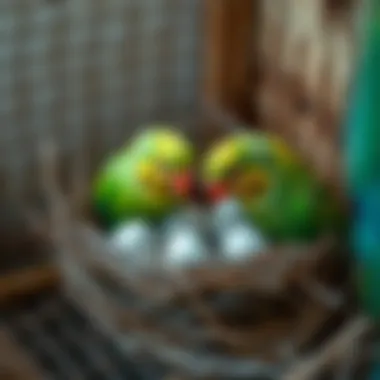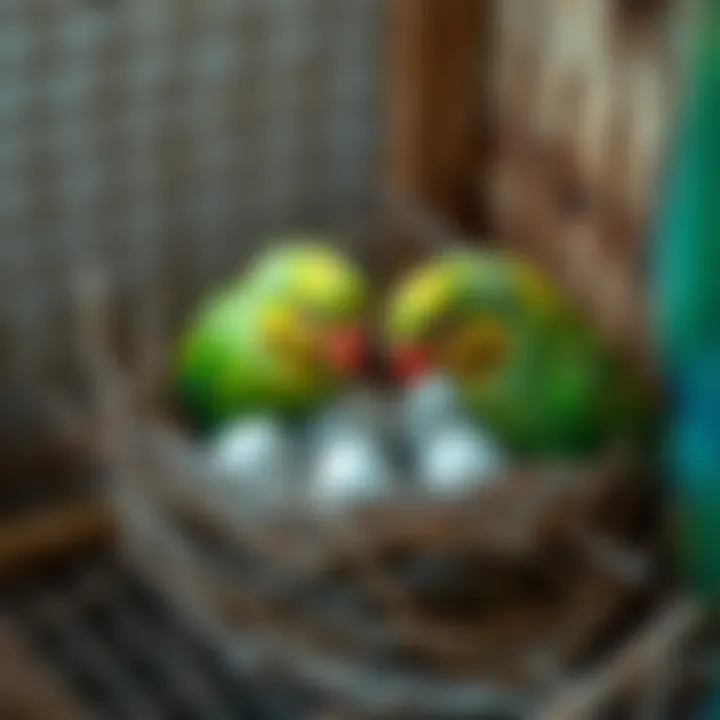Guide to Successful Conure Breeding Techniques


Intro
Breeding conures can be both a rewarding and intricate endeavor. These vibrant birds, known for their lively personalities, require careful consideration of various factors for a successful breeding experience. It's not just about putting a male and female together and waiting for eggs. There’s much more to the art of breeding than meets the eye. Knowing the right pair, providing a suitable environment, and understanding their reproductive cycles are critical elements to ensure the health of both the birds and their offspring.
In this guide, we will embark on an in-depth journey into the world of conure breeding. From crucial pair selection to the evolving needs during chick development, we’ll cover thorough techniques that will aid both novice and seasoned breeders. You’ll discover how to create the ideal breeding conditions, monitor egg care effectively, and nurture the chicks as they grow. Join us as we explore the enchanting world of conures, equipping you with essential knowledge and practical advice to enhance your breeding endeavors.
Understanding Conure Species
Understanding the various species of conures is paramount for anyone looking to breed these vibrant birds. Each species comes with its own unique quirks and requirements, making it crucial to familiarize oneself with their specific traits. This knowledge not only enhances the breeding experience but also ensures the health and happiness of the birds. By understanding their needs, you can create a suitable environment and make informed decisions, improving overall breeding success.
Common Types of Conures
When it comes to conures, the variety can be both delightful and overwhelming. Let’s take a closer look at some of the most common types that find their way into homes and breeding programs.
Green-cheeked Conure
The Green-cheeked Conure, often seen as a great starter species for novice breeders, has a charming personality and manageable size. Known for their playful nature, they tend to get along well in a breeding setup. Their key characteristic lies in their relatively calm temperament paired with a capacity for social interaction. The most attractive feature of this bird is its beautiful coloration, which consists of vibrant green feathers complemented by a splash of blue on the wings.
However, breeders should note that these birds can be prone to certain health issues if not properly cared for. This makes it necessary to individualize care plans based on their specific needs.
Sun Conure
Sun Conures are celebrated for their striking appearance, featuring bright yellows and shades of orange that make them a visual delight. Their main contribution to the breeding world is their outgoing personality; these birds are known to be vocal and expressive. This tendency to engage encourages social bonding, making them more appealing for those desiring a lively pet.
Their unique feature is the ability to develop a substantial language repertoire, making them quite the chatterboxes. However, the downside is their loud chatter may be overwhelming in a quiet household, so consider your living situation before introducing them.
Jenday Conure
Jenday Conures are another popular variety, easily distinguishable by their bright yellow bodies and green wings. They are known to form strong bonds with their owners and showcase a playful, explorative nature that can charm any bird enthusiast. This key characteristic ensures they are well-liked among pet owners.
Their unique feature is their adaptability; they often adjust well to different environments. Nevertheless, be wary of their need for social interaction; without it, they may develop behavioral issues, making it vital for breeders to ensure ample interaction time.
Blue-crowned Conure
Finally, the Blue-crowned Conure stands out with its stunning blue crown and slightly more reserved demeanor. This species is recognized for its intelligence and ability to learn new tricks easily, making it an attractive option for both breeders and pet owners. The key benefit of selecting a Blue-crowned Conure is its quieter nature compared to its vocal relatives.
However, they are not as cuddly and may prefer to keep some distance. This makes them a suitable choice for those who might not want a constantly affectionate companion.
Characteristics and Traits
Exploring the characteristics of conures goes beyond their social tendencies; it also involves understanding their temperament, lifespan, vocalization, and social behaviors. Each of these traits plays a significant role in the overall breeding experience, influencing everything from habitat setup to social interactions.
Preparing for Breeding
Breeding conures can be a worthwhile endeavor, but before diving headfirst into this adventure, preparation is crucial. Understanding the dynamics involved in breeding requires a good foundation; this means making educated choices about the pairs you select and establishing an optimal breeding environment. If you lay this groundwork thoughtfully, you’ll avoid a heap of headaches down the road and increase the chances of a successful breeding cycle.
Selecting Breeding Pairs
When it comes to breeding, the selection of appropriate pairs cannot be understated. Choosing the right combination of conures can set the stage for both healthy offspring and a smooth breeding process.
Age Considerations
Age plays a critical role in the breeding success of conures. Generally, it’s advised to select pairs that are between 2 to 5 years old, as this age range is typically when conures reach sexual maturity and are in their prime. Selecting a breeding pair at the right age can greatly increase the likelihood of fertile eggs.
Additionally, older birds often carry risks of breeding complications or health issues, so it's wise to keep this in mind. While younger conures may be eager, their inexperience can also lead to challenges during the mating process. Having age-aware strategies can lead to beneficial outcomes, as it ensures both parties are ready physically and mentally for the breeding journey.
Health Screenings
A thorough health screening is essential before any breeding occurs. This involves examining both potential breeding partners for any underlying health issues, as unhealthy birds can produce weak or non-viable offspring. Ensuring that both birds are free from diseases not only safeguards their health but also enhances the likelihood of a healthy brood.
In addition, a health check promotes a smooth breeding cycle, as healthier birds tend to exhibit better reproductive behaviors, thus increasing the chances of successful mating. Utilizing a qualified avian vet for these screenings might add an expense, but it also pays dividends in the longer term.
Genetic Compatibility
Understanding genetic compatibility is crucial to avoid inbreeding and related genetic disorders. When selecting a breeding pair, it’s important to know their lineage. Breeders who are oblivious to their birds' genetic backgrounds can inadvertently propagate health issues within the lineage, resulting in future generations that may suffer from congenital problems.
By spending time on genetic compatibility, you ensure that offspring have strong health prospects and diverse genetic traits. Mixing different lines can produce robust and adaptable conures, relieving some concerns about hereditary issues. It’s a decision that might require detailed research, but it’s well worth the investment of time for the welfare of the birds.
Creating the Right Environment
Once you've selected a breeding pair, your next step is to create an environment that caters to their breeding needs. The right setup is fundamental—it nurtures the birds and fosters a sense of safety and comfort essential for successful breeding.
Cage Size and Setup
The size of the cage is paramount. Ideally, the cage should be spacious, allowing the birds to move freely and engage in typical behaviors like flying or climbing. An adequate cage setup minimizes stress, which can have detrimental effects on the breeding process.
"A happy bird is a breeding bird."
In addition to space, the cage should include suitable perches, hiding spots, and toys to stimulate engagement and reduce aggression during mating. Think of this cage as their breeding sanctuary; if they feel comfortable, they're more likely to mate successfully.
Nesting Materials
Nesting materials play a pivotal role in creating an inviting place for the birds to lay eggs. Common options include shredded paper, soft grasses, or even pine shavings, which can be molded into a nest.
It’s important to offer various materials, allowing the birds to build nests that feel right for them. The unique feature of providing nesting materials is that it encourages natural behaviors, allowing the birds to engage in instinctual nesting practices. This engagement can enhance bonding between the pair, resulting in a higher likelihood of successful reproduction.
Temperature and Humidity Controls


Temperature and humidity greatly affect breeding conures. Ideally, you should maintain a stable temperature around 70 to 80 degrees Fahrenheit with humidity levels between 40% and 60%. A stable environment ensures the birds feel comfortable and secure, which is conducive for mating activities.
In hotter climates, birds can become stressed and become less likely to breed, hence monitoring these elements is crucial. Investing in a good thermometer and hygrometer can be very beneficial, ensuring that you can maintain the right conditions at all times.
In summary, preparing for breeding conures involves thorough research and thoughtful decisions. It’s about gearing up both birds and environment to ensure the best outcomes possible. Each of these steps holds significant weight in the success of breeding by paving a smooth path for the subsequent stages.
The Breeding Process
Understanding the breeding process is crucial for anyone considering breeding conures. This stage of the journey is not just about the act of mating; it encompasses a myriad of behaviors, environmental factors, and responsibilities that all contribute to the well-being of both the parents and the future chicks. Effective breeding can lead to healthy offspring and a fulfilling experience for the breeder. Key to success is being aware of the full spectrum of factors that can influence outcomes, from understanding mating behaviors to ensuring proper egg care.
Mating Behavior
Mating behavior is a fascinating aspect of conure breeding. It's not just a biological necessity but also a complex dance of communication, attraction, and compatibility. Through mating rituals, conures establish the bonds that will carry them through the rigors of parenthood.
Courtship Rituals
Courtship rituals are essential in determining the readiness of conures to mate. These rituals often include a mix of vocalizations, preening, and playful antics, which help solidify the bond between the breeding pair. Key characteristics of these rituals lie in their intricate displays; for instance, male conures may puff up their feathers and bob their heads while producing specific sounds.
These behaviors not only signal health but also serve as a way for the female to assess the male's suitability. A female who observes a male engaging energetically in courtship is more likely to find him attractive and suitable as a mate, which ultimately leads to successful breeding. However, one should note that not all courtship might result in mating; factors like stress or disruption can inhibit the process.
Mating Techniques
Mating techniques are the next step following courtship rituals and can vary widely among the different conure species. Generally, mating involves a certain degree of skill and timing. The male will mount the female, often gripping her feathers with his beak while copulating. This particular method minimizes distractions and keeps the female close during this crucial moment.
Importantly, the timing of the mating itself is also significant as females can be quite selective about when they participate. A key characteristic of these techniques is that they often take place multiple times over several days to ensure successful fertilization. However, with this can come the disadvantage of potential stress for the pair, especially if they feel pressured to mate without proper conditions.
Egg Laying
Once mating is successful, the focus shifts to egg laying, a defining moment in the breeding process. It is with this that the anticipation of new life begins, and understanding the signs of laying is paramount to preparing for the next steps in the journey.
Signs of Laying
Conures display several signs when they are ready to lay eggs. These indicators generally include nesting behavior, increased restlessness, and occasional squawking, which could suggest a nesting instinct kicking in. The female conure may start to gather nesting materials, so it's essential to provide her with appropriate options.
Identifying these signs is crucial because it allows the breeder to prepare the environment properly, ensuring it is conducive to the female's needs. However, a drawback is that sometimes, inexperienced breeders might misinterpret general behavior as signs of laying, leading to unnecessary concern.
Egg Care
The care for eggs is vital to ensure the health of the developing chicks. After a female lays her eggs, the journey of nurturing begins. This includes monitoring the eggs for any abnormalities or breakage. The key characteristic of egg care involves maintaining a controlled temperature and humidity level. This can require constant attention and adjustment, especially in varying climates.
One unique aspect of egg care is that both parents can be involved in incubating the eggs. This shared responsibility can be beneficial, as it allows both birds to take turns while avoiding burnout. However, if one parent is overly dominant, it might lead to complications, making it necessary for the breeder to monitor interactions closely.
Egg Incubation
Egg incubation is the final step before chicks come into the world. This phase involves keeping the eggs at appropriate temperatures, typically between 98 and 101 degrees Fahrenheit. Both conure parents tend to take turns ensuring that the eggs are warmed adequately, but the breeder should also step in, especially if the parents often leave their nest.
The advantage of understanding incubation is that it can mitigate the risks of egg neglect or exposure to unsuitable environmental conditions. However, this process can be quite labor-intensive, requiring the breeder to be vigilant about the health of the eggs throughout the incubation period.
In summary, the breeding process encapsulates a multifaceted interplay of behaviors and responsibilities that serve to enhance breeding success. Awareness of mating behaviors, egg laying signs, and effective egg care practices can set the stage for a fruitful breeding outcome. For conure breeders, this knowledge is indispensable in their quest to raise healthy, vibrant chicks.
Caring for Conure Eggs
Caring for conure eggs is a pivotal stage in the breeding process. The eggs represent potential new life, and how they are handled can significantly impact their chances of hatching and the health of the chicks that emerge. Proper care ensures that the eggs develop in a conducive environment, setting the stage for successful hatching and the overall vitality of the hatchlings.
Incubation Techniques
Temperature Regulation
Maintaining the correct temperature for conure eggs is crucial for their development. The optimal temperature generally ranges from 99 to 100 degrees Fahrenheit. It's not just about hitting the right number; it’s about consistency. Fluctuations can lead to poor development or even embryonic death.
One of the key characteristics of effective temperature regulation is its ability to mimic what a mother bird would provide. This method creates a stable environment that can result in higher hatch rates. A popular choice for breeders is using automatic incubators that have built-in temperature control. However, these can come with their downsides, such as the need for electricity and potential malfunction. More traditional methods, while less common now, can be just as effective with careful monitoring.
Turning the Eggs
Turning the eggs regularly is another crucial step in providing proper care. Typically, eggs need to be turned about three times a day. This mimics the natural behavior of parent birds, preventing the embryo from sticking to the shell and ensuring even development.
This process’s primary benefit is its simplicity and effectiveness. A unique feature is that it allows for gentle adjustments in position without the risk of damaging the egg. On the downside, forgetting to turn them or being inconsistent can drastically reduce hatch rates. For that reason, many breeders recommend marking eggs with a pencil to keep track of their positioning.
Monitoring Humidity
Humidity control is perhaps less intuitive but just as significant in breeding. For conure eggs, keeping humidity levels around 40–50% during incubation is optimal. This prevents the eggs from drying out or absorbing too much moisture.
The key characteristic of monitoring humidity lies in its direct impact on the success rate of hatching. Specialized hygrometers make it easier to track levels consistently, and adding water pans to the incubator can help maintain stable humidity. A potential downside is that high humidity can lead to condensation inside the eggs, which can cause developmental issues. Therefore, one must balance these variables carefully.
Identifying Fertility
Candling Eggs
Candling is an age-old technique used to identify the fertility of eggs. By shining a light through the egg, one can see the internal structures and determine whether an embryo has formed.
Its benefits include the ability to monitor the progress of the development without opening the eggs. This non-intrusive method allows breeders to remove non-fertile eggs, which can help maintain environmental quality within the incubator. However, improper candling techniques can lead to misinterpretation of an egg’s status, potentially impacting hatch rates negatively.
Expected Hatch Dates
Understanding expected hatch dates is vital for planning and preparation. Conure eggs usually hatch about 24 days after being laid, but this can fluctuate based on factors such as temperature and humidity conditions.
Knowing when to expect hatching can help breeders prepare adequately, providing a nurturing environment for the chicks' arrival. One unique feature of tracking hatch dates is leveraging a calendar or app for alerts, ensuring that you don’t miss those crucial moments. The risk associated is assuming that all eggs will hatch around the same time, which may not be the reality and can lead to disorganization in care.


"Observation and attention to detail can make all the difference when it comes to breeding conures. Every stage counts, especially during egg care."
By understanding the intricacies of caring for conure eggs, breeders can set the foundation for a successful breeding experience, paving the way for healthy, vibrant chicks.
Chick Development
Chick development stands as a pivotal phase in the journey of breeding conures. It encompasses several stages that directly influence the health, behavior, and ultimately the future of these vibrant birds. A keen understanding of chick development allows breeders to provide the essential nurturing needed for thriving offspring.
This period, while often filled with excitement, also comes with its own set of challenges and responsibilities. Being well-informed aids in not just the survival but the flourishing of newborn chicks, which sets the stage for their integration into homes or aviaries later on.
Hatching Process
Signs of Hatching
Recognizing the signs of hatching is crucial in the overall breeding process. These signals typically include peeping sounds coming from the eggs, or small cracks appearing in the shells. When breeders observe these signs, it becomes a moment of vigilance and anticipation. The excitement isn’t just about waiting; it’s also about preparing for the next steps.
A key characteristic of observing hatching signs is the anticipation it builds. Breeders gain the opportunity to provide necessary assistance if complications arise. While it may be tempting to intervene immediately, patience often proves rewarding, as many chicks can hatch successfully without help.
However, if there are no further developments after a reasonable period, intervention may be warranted. This decision brings its own risks; therefore, one must weigh the benefits against the potential harm to the chick. Breeders who are attuned to the signs of hatching often notice the unique feature of gradual progress, providing them with insight into the chick's health.
Assisting Chicks
At times, hatchlings may require assistance in freeing themselves from their shells. Understanding when to step in requires a balance of instinct and knowledge. This aspect of breeding plays a key role in ensuring that chicks don’t struggle excessively, which can lead to exhaustion or, worse, failure to hatch.
The main advantage of knowing how to assist chicks is that it ensures higher survival rates. However, the challenge lies in exercising caution. A unique feature here is that too much help can cause damage to the delicate chick.
Breeders often find that maintaining a watchful but hands-off approach is best, intervening only when absolutely necessary. The decisions made during this critical window hugely impact the overall health of the chicks and their ability to thrive.
Nurturing Newborn Chicks
Feeding Requirements
Newborn conure chicks have specific feeding requirements that need to be accurately met to ensure healthy growth. Initially, these chicks will depend solely on a specially formulated hand-feeding formula, which mimics the nutritional content of their parent’s regurgitated food. Getting this right is essential as it directly affects their early development and vitality.
The feeding process is not merely about quantity but also of consistency and temperature, as the formula must be provided at a warm temperature. A critical characteristic of the feeding requirements is the schedule; chicks must be fed on a strict timetable to mimic natural feeding instincts.
Inadequate or irregular feeding can lead to various health issues such as stunted growth or digestive problems. Thus, the unique feature of this stage is the combination of precision and regularity needed to foster healthy, vibrant chicks.
Temperature Needs
Temperature is another critical factor in the development of newborn chicks. They require a warm environment to thrive, as they are unable to regulate their body heat during the early days of life. An ideal temperature ranges between 90 to 95 degrees Fahrenheit for the first week, gradually decreasing as the chicks age.
This aspect of chick nurturing can’t be overstated; a stable, warm environment supports feeding and resting, both crucial for growth. The importance of monitoring temperature is in preventing hypothermia, which can quickly turn fatal for delicate chicks.
Maintaining the right temperature also encourages the chicks to socialize and develop essential behaviors, setting the stage for their social lives.
Socialization
Socialization is one of the more overlooked aspects of nurturing newborn chicks. Even at a young age, chicks benefit from interaction—not just with their parents—but also with humans and other conspecifics. Early social experiences play a substantial role in shaping a bird’s behavior as it matures.
A critical attribute of socialization is its connection to temperament. Chicks that are handled gently and frequently tend to grow into more friendly and well-adjusted adults. The challenge can be in striking a balance; too much handling can stress them, yet too little can result in timid behavior later on.
Overall, a careful approach to socializing young conures results in birds that are not just healthy physically, but also well-rounded emotionally, which is invaluable for future companionship with humans and other pets.
Health Considerations
Maintaining a focus on health is critical when breeding conures. Understanding their specific health needs can greatly influence the success of breeding efforts and the vitality of both parents and chicks. Healthy birds are more likely to produce healthy offspring, making it crucial to pay attention to common health issues, preventive care strategies, and to ensure overall well-being. The approach to health can also shape breeders' practices, reinforcing the significance of establishing a solid foundation for breeding pairs.
Common Health Issues
Respiratory Problems
One of the key health challenges conures face is respiratory issues, which can greatly impact their quality of life. Conures are particularly vulnerable to environmental stressors such as drafts, poor air quality, and exposure to smoke. The signs often include wheezing, nasal discharge, and labored breathing. Addressing respiratory problems is not just about identifying symptoms; it requires a proactive approach to housing and care.
In this article, understanding respiratory conditions can help breeders create a safe environment for their birds. It's important because respiratory illnesses can become severe if left untreated, leading to complications that may threaten the birds' life. Ensuring proper ventilation and keeping cages clean are simple yet effective preventative measures.
Digestive Disorders
Digestive disorders are another prominent concern for conure owners and breeders alike. These disorders can stem from various factors such as diet, stress, and insufficient hydration. Symptoms often show up as changes in droppings, weight loss, or lethargy. Recognizing the signs early is essential for effective intervention, especially since a healthy digestive system is crucial for nutrient absorption.
The discussion on digestive health emphasizes the importance of a well-balanced diet filled with the right mix of seeds, pellets, fruits, and vegetables. Addressing these unique dietary needs can prevent issues and promote long-term health, making it a vital area of consideration for breeders focused on improving chick survivability.
Genetic Conditions
Genetic conditions are not as visible as respiratory or digestive troubles, yet they deserve attention for ethical breeding practices. Some conures may be prone to hereditary conditions, which can affect their lifespan and overall health. This aspect falls into the realm of genetics, where careful selection of breeding pairs can either mitigate or amplify genetic risks.
Being informed about genetic predispositions can guide breeders in selecting compatible pairs, ultimately leading to stronger and healthier offspring. This awareness also reflects on the responsibility that breeders hold in ensuring the genetic diversity and health of the conure population.
Preventive Care
Vaccination Schedules
Preventive care is essential to maintaining the health of breeding conures, and following a vaccination schedule is a significant step. Vaccinations protect birds from certain diseases that can have devastating effects on their health. Common vaccines for conures may include those for psittacosis and polyomavirus.
Breeders who adhere to a strict vaccination regimen often see fewer health issues arise in their flocks. Regular vaccinations can enhance the immunity of the birds and diminish the risk of outbreak in aviaries where several birds are housed together. The benefits of staying on top of vaccinations are clear: it creates a healthier environment for breeding and raises the overall quality of life for the birds.
Regular Health Checkups


Integrating regular health checkups into the routine for conures is equally important. Routine veterinary visits can help catch potential health problems early on, preventing small issues from snowballing into major ones. These checkups allow for timely monitoring of a bird's weight, plumage, and overall behavior.
Establishing a relationship with an avian veterinarian can facilitate better understanding of individual birds’ health needs, helping to customize care plans when necessary. Health checkups should be seen as a proactive strategy that enables breeders to ensure each bird is thriving, which eventually translates to more successful breeding outcomes.
Regular health assessments go a long way in promoting the wellness of your breeding conures, ensuring a joyful breeding experience while safeguarding their health.
By paying attention to these health considerations, breeders can not only enhance their breeding practices but also contribute positively to the welfare of conures as a whole. Keeping health at the forefront can yield richer lives for both breeders and their beloved birds, setting the stage for successful breeding outcomes.
Post-Breeding Care
Post-breeding care is a crucial stage in the life cycle of conures that can significantly influence the well-being of both parents and their offspring. Following the intense process of breeding, it’s vital to steer clear of complacency. This period is not just about tending to the chicks; it’s an encompassing approach that ensures the health, development, and social integration of young conures. The importance of post-breeding care cannot be overstated as it encompasses practices that help in the transition of young birds from reliance on their parents to independent living.
Weaning Process
Transitioning to Solid Food
Transitioning to solid food is an essential step in the weaning process of conure chicks. At around 6 to 8 weeks of age, these affectionate little creatures gradually begin to eat solid foods, a phase critical for their development. Providing the right kinds of solid foods not only fulfills their nutritional needs but also prepares them for a life away from parental care.
The key characteristic of transitioning to solid food lies in its necessity for healthy growth. Foods like pellets, fresh fruits, and vegetables are excellent choices as they offer a balanced diet. The unique feature of solid food is the variety it introduces to the chick's diet, promoting exploration and curiosity. However, relying solely on one type of food can lead to nutritional deficiencies. Therefore, introducing a balanced diet rich in variety is an advantageous strategy that boosts not just health but also the overall vitality of the young conure.
Monitoring Development
Monitoring development is a continual responsibility during the post-breeding phase. This involves observing growth patterns, feather development, and behavioral changes. The objective is to ensure that the young conures are thriving and adjusting well to their diet and environment.
One key characteristic of monitoring development is the ability to catch potential health issues early. By keeping an eye on their weight and activity levels, breeders can identify discrepancies that may suggest dietary or health concerns. A unique aspect of diligent monitoring is its role in enhancing the bond between the breeders and the young birds, as it fosters a more compassionate caregiving approach. However, excessive over-monitoring can lead to stress for both the birds and the breeder, so it's crucial to strike a balance.
Socializing Young Conures
Socializing young conures is another pivotal aspect of post-breeding care. Proper socialization ensures that these birds grow into well-adjusted and affectionate companions. During their early days, interacting with them establishes trust and helps ease their integration into different environments.
Handling Techniques
Handling techniques refer to the methods employed to interact with young conures in a way that promotes comfort and trust. Gentle handling fosters a sense of security in the chicks, essential for their emotional development. Regularly spending time with them helps them acclimate to human presence, which is why it's often perceived as a beneficial choice for both the birds and their future families.
A key advantage of proper handling techniques is that they instill confidence in young birds. Birds that are handled gently tend to remain calm and friendly as they grow, making them more suitable for adoption or companionship. Further, improper handling can result in fear or aggression, creating long-term behavioral issues. Hence, employing suitable handling techniques during this crucial phase enhances overall success for future interactions with both humans and other birds.
Introducing New Companions
Introducing new companions is yet another important task in ensuring that young conures become well-rounded birds. This process goes beyond merely adding another bird to the household; it involves understanding social dynamics between pets. Gradual introductions allow young conures to adapt to their new friends without feeling threatened or overwhelmed.
One striking characteristic of this practice is how it can enrich the social skills of the birds. Whether it's another conure or a different species, a smooth introduction provides the chance for the young birds to learn important social cues. While introducing multiple companions can be a delightful experience, it also presents the challenge of monitoring interactions to prevent conflicts. The benefit of successfully integrating new companions outweighs its complexity, as healthy social relationships greatly contribute to the overall happiness and mental health of your feathered friends.
"A balance between proper nutritional transitions and social exposure is key for raising well-rounded conures that thrive both physically and emotionally."
Ethical Breeding Practices
Breeding conures isn’t just about producing more birds; it’s about doing so responsibly and ethically. The health and wellbeing of both the parent birds and the chicks should be at the forefront of any breeder's mind. Ethical breeding practices ensure the continued vitality of conure populations while fostering a positive relationship with these unique creatures. Many aspects come into play, balancing genetics, bird welfare, and the integrity of the breeding process. It’s essential to have a good grasp of these practices for the long-term success of your breeding efforts.
Understanding Genetic Diversity
Genetic diversity is crucial in maintaining the overall health of the conure species. When breeding, it's vital to avoid inbreeding. Inbreeding occurs when closely related birds mate, leading to a higher risk of genetic disorders and decreased vitality among offspring. The characteristic of high genetic variability contributes to the robustness of a population. Avoiding inbreeding offers several benefits including better resistance to diseases and a stronger immune system.
In terms of practicality, diversifying breeding pairs may seem a bit like trying to find a needle in a haystack, but the advantages far outweigh the challenges. By selecting unrelated birds, breeders can create a lineage that not only thrives but stands the test of time. It’s a strategy that builds sustainability into your breeding practice, keeping the risks of health issues at bay.
Creating Healthy Lineages
Equally important is creating healthy lineages. This aspect ties back into keeping genetic diversity at the forefront. Healthy lineages ensure that future generations have a strong foundation to build upon. The hallmark of a healthy lineage is not only its genetic variability but also the history of health within that line. By researching family backgrounds of potential breeding pairs, breeders can make informed decisions that benefit the well-being of their birds.
The unique feature of intentionally creating lineages is that it fosters traits that are desirable in the long run—be it for temperament or physical robustness. The down side? It requires diligent record-keeping and constant education about your birds' health conditions. Yet, when executed correctly, the advantages become clear: vibrant, thriving, and more resilient chicks coming from a conscientious breeding practice.
Ensuring Bird Welfare
When you breed, ensuring the welfare of your birds must be foundational. This links not only to genetic health but also to their living conditions. Proper housing is central in achieving a safe and comfortable breeding environment. Having spacious cages with appropriate perches and toys can work wonders for the mental and physical health of the birds. It provides an environment where they can thrive and feel secure enough to breed.
On the flip side, improper housing can lead to stress and hinder breeding. Crowding birds can lead to aggression or other behavioral issues that detract from the breeding process. By prioritizing proper housing, one can uplift the overall breeding experience and encourage normal behaviors that contribute to successful breeding.
Dietary Needs
Lastly, dietary needs of conures shouldn’t be taken lightly. A balanced diet is essential for their health and reproduction. Providing an array of fresh fruits, vegetables, seeds, and specially formulated pellets is crucial. A good dietary regimen aids in keeping the birds' immune systems robust and prepares them for breeding.
The key characteristic here is that not feeding them properly can have dire consequences. Poor nutrition can lead to weak hatchlings or even force a breeding pair to abandon eggs. Consequently, ensuring dietary needs are met will not only enhance breeding results but also solely ensures healthy birds for the breeders. It's one aspect where investing time and resources pays off significantly in the long run.
Keeping the focus on ethical practices in breeding ensures not only the health of individual birds but the species as a whole. With good practices, both the breeders and the birds enjoy a sustainable future.
Epilogue
Breeding conures is a journey that demands both knowledge and commitment. The importance of conclusion in this guide is to synthesize the vast array of information presented and underscore the key elements that contribute to a successful breeding experience. Ny understanding the nuances of conure breeding, from selecting the right pairs to ensuring the welfare of the chicks, potential breeders can navigate this complex process with greater confidence.
Recap of Key Points
Throughout this guide, we've covered several vital aspects that every breeder should consider:
- Understanding Conure Species: Becoming familiar with the various types of conures, including their characteristics, can help in selecting the best breeding pairs.
- Preparing for Breeding: Choosing suitable pairs based on health and compatibility sets the stage for successful breeding.
- The Breeding Process: Observing mating behaviors and caring for eggs is essential in increasing the chances of hatchling survival.
- Caring for Conure Eggs: Adhering to proper incubation techniques ensures the fertility of the eggs.
- Chick Development: Knowing how to nurture newborns, including their feeding and social needs, will promote their health as they grow.
- Health Considerations: Being aware of common health issues and preventive care can make a significant difference in the well-being of both parents and chicks.
- Post-Breeding Care: Managing the weaning and socialization process effectively ensures that young conures develop into happy and well-adjusted adult birds.
- Ethical Breeding Practices: Upholding the welfare and genetic diversity of conures is crucial for sustainable breeding.
Encouragement for Future Breeders
For those contemplating getting into breeding conures, consider this: while the process can appear daunting at first, it is also incredibly rewarding. Knowledge and preparation are your best allies in this endeavor.
By equipping yourself with the facts presented in this guide and being mindful of the birds’ needs, you will be better prepared to face challenges head-on. Remember, successful breeding extends beyond just producing chicks; it involves raising them in an environment where they can flourish. Each step taken is a leap toward contributing positively to the lives of these vibrant avians.
Happy breeding!
For further reading, check out resources like Wikipedia on Conures, Britannica, and discussions on communities like Reddit.







